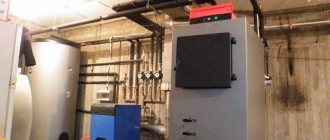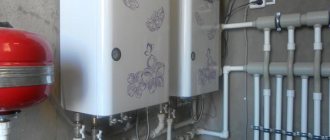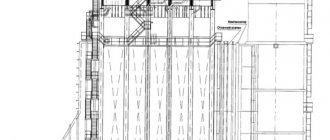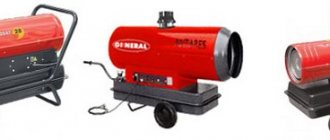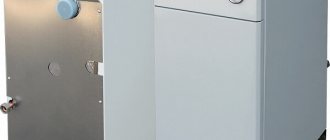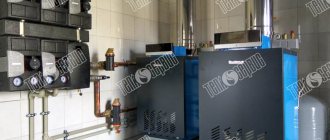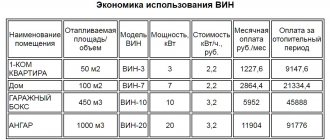The history of the creation of a parapet gas boiler
The floor-mounted turbocharged boiler has a closed combustion chamber, therefore it is safe and does not require a separate room
The product was created in the early nineties of the last century, when mass private construction began and people abandoned central heating. The universal stoves used at that time could operate on any fuel, but they had an open-type burner installed. Since domestic enterprises were closing en masse, and foreign products were unavailable, it was decided to develop and put into production a boiler of our own production that meets all power and safety requirements.
The work was carried out in Ukraine and Luch Russia. In 1996, the first two-circuit samples went on sale, with a compact design, a power of 10 kW, an efficiency of 0.92 and a closed combustion chamber. These boilers became the prototypes of units that are still manufactured today.
What are parapet gas boilers and their structure
The main difference between a parapet gas boiler and devices of a similar type is energy independence. The incoming fuel burns by igniting the burner in a closed chamber, smoke and combustion products are discharged through a coaxial chimney.
The structural diagram consists of a set of basic and additional elements:
- igniter;
- closed gas combustion compartment (chamber);
- burners;
- steel heat exchanger in a single-circuit device;
- heat exchanger and secondary type copper coil in a dual-circuit model;
- coaxial chimney.
The unit is enclosed in a durable steel case and equipped with a security system, which includes draft sensors, a thermocouple, and a thermometer.
Features of parapet boilers:
The coaxial chimney pipe is a double system. The chimney works to intake air to create a gas-air mixture, which burns in a closed chamber, and to remove combustion products. The special burner design ensures increased efficiency of parapet models. The absence of forced air supply is a property that allows you to create a non-volatile autonomous network in the house
This is especially important for buildings located outside the city. The convection principle of operation of the device ensures rapid heating of the premises. Efficiency of heating by perforating the steel casing is achieved; thermal energy is transferred directly to air flows, thereby increasing the efficiency of the equipment. The sealed combustion chamber minimizes the risk of release of combustion products, so people in the house are protected from gas poisoning.
Advantages and disadvantages of parapet boilers
In addition to the fact that a double-circuit parapet gas boiler will provide heat and hot water in the house, the devices have a number of additional advantages.
Experts highlight the following advantages of purchasing single- and double-circuit models:
- No restrictions on the location of the device. You will only need the proximity of an external wall, through which you will have to bring out a coaxial type chimney; a regular chimney will not be useful.
- Small dimensions of the device. The parapet model can be installed in the kitchen or bathroom of a private house, if one of the walls is external. The boiler body is equipped with perforations, so there is no need for an additional heat source in the installation area (room). The device serves as a kind of stove, warming both the room in which it is installed and other rooms of the house.
- Versatility. There are no restrictions on the installation of units; if installation conditions exist, the devices are installed in private houses, apartments of multi-storey residential buildings.
- Having a choice. Single- and double-circuit models with power ranging from 15-40 kW are available for sale. The most productive units are designed for heating houses with a living area of up to 200 m2.
Affordable cost is one of the main advantages of the models. Compared to standard type equipment, parapet boilers are 30-45% cheaper. There is one minus - the devices are not designed for heating large rooms. When choosing boilers with a power of 20 kW, suitable for heating more than 100-150 m2, care must be taken to thoroughly insulate the building. Otherwise, an additional heating source will be needed.
Boiler structure
The heating device is small in size, which makes it possible to install it in the kitchen, bathroom or basement level. The presence of convection openings in the body allows the unit to be used as an oven, which makes it possible to avoid installing piping and batteries indoors.
The structure of the products is quite simple:
- durable body covered with heat-resistant enamel;
- closed combustion chamber;
- gas-burner;
- wick;
- heat exchangers (coils made of copper or brass);
- chimney with wind protection.
The product includes automatic control and monitoring devices. These include a thermocouple, an air draft sensor and a thermometer.
Main differences and characteristics
Parapet boilers can have 1 or 2 circuits - for heating and hot water.
Various models are made in floor and wall-mounted, left-hand and right-hand versions. Depending on the purpose, they are equipped with one circuit - only for heating or two - to additionally heat water for domestic purposes. Depending on the level of control, devices can be automatic or manual. For automation to work, electricity is required. If it disappears, the boiler turns off. Manually controlled products are practically independent of external conditions and can even be operated from a gas cylinder. The burner is turned on and off by a thermocouple and a constantly burning wick.
Model overview
If you choose the right manufacturer and model of the boiler, it will be able to effectively heat your home even without the “help” of additional equipment.
Thus, Danko gas boilers have a power of 7 to 15 kilowatts, so they are quite capable of handling a room with an area of up to 140 square meters. All devices from this manufacturer have an automatic gas supply system, micro-torch burners and piezo ignition. The walls of the heat exchanger are 3 millimeters thick.
It is characteristic that the design of this exchanger has been updated, and the right-left connection is ignored in principle. This makes installation easier. The connection in this case is two-way, which significantly saves work space. There is also a special panel that allows you to adjust the operation of the device and visually monitor it.
Video parapet boiler – Model “Danko 7U”
ROSS is one of the largest Russian manufacturers of gas equipment. Boilers from it are known to ordinary users as AOGV and have a power of up to 100 kilowatts.
Parapet boiler Aton Compact
The boilers of the Aton series are no less popular, since considerable funds have been invested in this company in recent years. The boilers are produced using modern equipment, thanks to which excellent external performance of the products is combined with high quality.
Video – Model “Aton Compact 7E (mini)”
Gas parapet boiler Zhitomir
There are also Zhitomir gas boilers, which are perfect for heating a multi-storey building. The fuel combustion chamber in them is absolutely sealed and equipped with automatic process control, a temperature control device, piezo ignition and a built-in gearbox. Each of the boilers has pipes for connection to the heating system on both sides.
The manufacturer guarantees that all products are absolutely safe to use, since they are tested seven times for failure-free operation in emergency conditions. If we talk about efficiency, then it can reach 90 percent.
Video - Advantages of Zhitomir models
https://youtu.be/MjKgQnKvyDE
Attention! The cost of parapet boilers ranges from 11,250-25,000 rubles, although there are more expensive models. It all depends on the technical parameters and the manufacturer.
Advantages and disadvantages
The main advantages of parapet boilers:
- high performance;
- closed combustion chamber ensuring complete safety;
- compactness;
- functionality;
- versatility;
- ease of use and maintenance.
The disadvantages include the need to drill a hole in the wall for the pipe, which negatively affects the supporting structures. If installing a gas boiler in a private house is not a problem, then equipping a city apartment with it is almost impossible, due to the current moratorium on such events. We should not forget about the high cost of equipment and installation work.
Rules and installation locations
Equipment of this type is used in rooms where a traditional chimney is not provided. A parapet gas boiler can be installed anywhere in the house thanks to a closed combustion chamber and a coaxial chimney, but the main condition is its location near the wall. This ensures that the coaxial pipe is brought out to the street.
A coaxial chimney is a stainless steel structure consisting of two pipes of different diameters located one inside the other. Thanks to this design, a space is provided through which air mass flows to ensure gas combustion. Combustion products are removed through a pipe of smaller diameter. The coaxial chimney is directed through the wall to the street, and wind protection must be installed. After this, the installation of flue pipes, heating circuits and hot water supply is carried out.
Installing the equipment is quite simple, but doing it yourself is strictly prohibited. You should contact licensed specialists. Connection to the gas main is made exclusively by gas service employees.
This is important: what standards exist for installing heating boilers in a private home.
Principle of operation
The operation of a parapet boiler differs little from the usual operation of gas convection units.
The burner heats the coolant, which transfers part of the energy to prepare DHW or is discharged into the heating circuit after preparation in a three-way valve.
There are no changes in this. A specific feature is the ability of the boiler to perform the function of a convector, which makes it possible not to install radiators in the room where the unit is located.
In addition, a special method of air supply and smoke exhaust is used. When the burner is ignited, excess air pressure arises in the upper part of the combustion chamber, causing it to be expelled along with the smoke outside.
At the same time, a vacuum is formed in the lower part, creating a suction of fresh flow through the outer part of the coaxial pipe. A pressure difference arises similar to that used in conventional ovens.
This allows the use of a closed combustion chamber without a turbo fan.
IMPORTANT! In some designs, the chimney and air intake pipe are made separately, but this does not change the principle of operation.
Specifics of the design of parapet boilers
Before buying a parapet gas boiler, the consumer should familiarize themselves with the specifics of its operation. The main distinguishing feature of such devices is energy independence, ease of removal of combustion products through a coaxial chimney, and the use of a closed combustion chamber. This design allowed the developers to combine the strengths of traditional gas boilers and environmentally friendly convectors in one device. Thus, the parapet gas boiler, reviews of which are positive, is a safe and practical heater that can be used to effectively heat rooms with a small area.
The boiler structure is represented by the following elements:
- gas valve;
- burner for burning energy;
- sealed combustion chamber;
- vertical flue;
- steel body.
At first glance, the design of a parapet boiler differs from the design of a traditional analogue only in the presence of an integrated vertical flue, through which exhaust gases are removed outside and air is taken from the street to prepare an optimal gas-air mixture. If we approach the analysis of the design features of the parapet boiler in more detail, we can note the following features:
- a steel body with special holes participates in the process of convective heating of air and improves the efficiency of the boiler;
- the use of a closed combustion chamber makes the device safe and protects households from accidental carbon monoxide poisoning;
- the presence of a unique gas burner device ensures maximum productivity and efficiency of the device;
- The non-volatility of boilers increases the autonomy of the heating system and eliminates the need to use forced air.
Double-circuit parapet gas boilers have a slightly modified design; prices start at two hundred dollars. The design of these models is characterized by the presence of an additional circuit. It is involved in the process of supplying hot water for domestic needs. Passing through an additional circuit, running water is heated to the temperature specified by the thermostat settings. It can be used by residents when opening the appropriate tap in the bathroom or kitchen. This device improves the functionality of the boiler and expands its scope of application.
Rating of TOP 5 parapet gas boilers
Parapet boilers do not have many of the disadvantages of wall-mounted models, so their range is constantly increasing.
Let's look at the most popular models:
Lemax Patriot-20
Floor-mounted parapet boiler produced by the Taganrog plant. The power of the unit is 20 kW, so the size of the room should not exceed 200 sq. m. m .
Only the basic task is performed - heating the coolant. If you need to expand the functionality, you should purchase and connect an external storage boiler.
Boiler parameters:
- Efficiency - 87%;
- coolant temperature - 80°;
- system pressure - up to 2 bar;
- gas consumption - 1.2 m3/hour;
- dimensions - 670x790x400 mm;
- weight - 67 kg.
Prices: summary table
Rating of the most popular models of parapet gas boilers:
| Model name | DHW, l/min | power, kWt | Efficiency, % | Flow, m3/h | price, rub. |
| LEMAX Patriot-12.5 | —— | 12,5 | 87 | 0,75 | 18 500 |
| ATON Compact-12.5EB | 5–6 | 12,5 | 90 | 1,53 | 25 000 |
| TERMO MAX C-12E | —— | 12,0 | 90 | 1,39 | 18 000 |
| Hephaestus VPR KSG-10S | —— | 10,0 | 92 | 0,60 | 21 500 |
Installation of a boiler in a house: SNiP standards
Before installation work, you must obtain all permits. Self-installation is not only illegal, but also unsafe (especially if the device will be used in a high-rise building).
The basic requirements and standards for gas equipment are written in SNiP 42-01-2002 “Gas distribution systems”. Also, many requirements can be read in SNiP “Gas Supply” 2.04.08-87. This document is no longer relevant today, but it still contains useful information.
Project
When there are technical conditions, you should start developing an installation plan.
The project represents an installation diagram, as well as laying a gas main from the point of connection to the city gas communication network. For the private sector, a drawing of the passage of gas communications throughout the entire site is additionally required. The entry point to the house must be marked. The project will be developed by engineers. In this case, all provisions of the GOS are taken into account. The design company must have a license for this type of service.
Installation Requirements
If the basic installation requirements are not met, this may result in complaints from the neighbor. Combustion products have a special odor and are harmful to human health. Also, violation of the requirements may affect the stability of the equipment - the unit may regularly go out, not light up, or smoke. These shortcomings are corrected by re-installation with the involvement of professionals.
Boilers should be placed on the external walls of the house. The distance from the facade is from 0.3 to 3.0 meters (the indicator depends on the power of the boiler). The chimney is installed only in open rooms. The wall intended for installation should be treated with non-flammable and fire-resistant materials.
Boilers should never be installed dangerously close to upholstered furniture, curtains or other flammable materials. The room where the equipment will be installed must be equipped with a high-quality ventilation system. The power of the unit is selected according to the size of the house that needs to be heated.
DIY installation
The bulk of the work on assembling and installing the boiler can be done independently. But some steps are best left to professionals - mistakes can be very expensive. This applies to the installation of chimney pipes for coaxial chimneys, as well as the first start-up. The exact installation process varies depending on the specific model. Each boiler comes with detailed instructions, where the manufacturer describes all installation steps:
- The first thing to do is to arrange a channel where the chimney and air pipes will be routed. What should the dimensions be? The holes must match the diameter of the pipe.
- A suitable place for the chimney is next to the window. In the future, this element will need to be serviced and its condition checked.
- Next, install the first duct pipe. It is fixed to prevent displacement. Then the section for the water supply is installed.
- On the surface where it is planned to install a parapet double-circuit gas boiler, studs are fixed. The unit body is secured with nuts.
- The pipes and chimney are installed in the same way, and the fasteners are fixed. In this case, you need to try to achieve maximum compaction between all elements. It is better to place the chimney at an angle. This way condensate is removed more efficiently.
- The chimney section is connected to the pipe, and protection is installed. The gaps should be adjusted so that the burner fire burns evenly and there are no tears.
- Then radiators and pipes are connected using standard technology. It is also worth installing an expansion tank.
- After installation, the equipment is checked by gas industry specialists. Then instructions are given. Only then can operation begin.
Advantages and features of parapet units
The main advantage of the equipment is its compactness: a parapet boiler running on gas can easily fit in the kitchen under a window sill or in any other room, since during operation it does not consume oxygen from the room and does not pose a danger to residents. A coaxial chimney is a reliable and safe smoke removal system, which also offers a choice in favor of such equipment.
The correct choice of product should be based on the following parameters (except for consumer reviews and catalogs from selling companies):
- Installation technology: the parapet boiler is made for mounting on walls and floors; there are also left- and right-hand models;
- A gas parapet boiler can be equipped with one or two circuits. One circuit is for heating only, the second circuit is for domestic hot water;
- Also, parapet boilers can be energy-dependent (with an automatic monitoring, adjustment and control system) and non-volatile (with or without manual adjustment).
Technical characteristics of universal boilers
The thermal power possessed by parapet boilers varies between 15 kW-40 kW for a unit with one circuit. If you choose to install parapet equipment with two water heating circuits, then the capacity for heating water for domestic needs should also be added to the rated power. For example, parapet boilers with a power of 12 kW -15 kW easily heat the volume of water up to 180 l/h, which, according to the standards, is four water points (faucets, toilets, faucets, showers, etc.).
- The single-circuit unit has a standard heat exchanger (jacket) of a plate design, which speeds up the process of heat exchange between the gas burner and the working fluid of the heating system. The material of the shirt is thick 3 mm steel.
- Double-circuit gas parapet boilers contain, in addition to the heat exchanger, a copper or brass coil for hot water supply, in which water is heated only by the flow method. If you increase the productivity of the hot water supply due to an additional hot water tank, then such a boiler will no longer be able to be installed in the kitchen.
Also, in addition to wall-mounted and floor-mounted models, there are products with differences in installation: with left-side connection of the gas pipe, hot water supply and heating circuit, and with right-side connection. This convenience should not be overlooked when choosing a boiler for an apartment or house. The dimensions of the unit are determined by its performance and the number of water heating circuits. For example, if a boiler has one circuit, then its dimensions will be smaller than that of a double-circuit one.
Types of boilers by power
Installation of a parapet boiler
Parapet gas boilers are fire hazardous equipment, and therefore self-installation of the equipment is prohibited.
Installation and installation work of this type of equipment can be performed by certified craftsmen, and connected to the gas network by representatives of the city gas company.
Violation of these rules creates a danger to people's lives and can damage equipment.
Parapet boiler installation process:
- Exit the smoke exhaust system through the external wall of the room into the environment.
- Protect the top of the pipe with a windproof cap so that powerful winds do not tear the torch away from the nozzle.
- Install pipes for the water, gas network and hot water supply; it may be necessary to constantly maintain pressure, with installation in the pump circuit.
- The wall intended for installation of the unit is treated with fireproof materials for fire safety.
- The combustion room is equipped with a ventilation system.
- To comply with fire safety, it is prohibited to install the boiler closer than 0.5 m to furniture, wood or any other flammable objects.
- It is prohibited to remove the chimney in closed rooms, rooms made of SIP panels, entrances, and attics.
- Equipment is selected according to a previously completed thermal design design.
- The algorithm for the sequence of installation work depends on the device model. Specific instructions for intermediate stages of installation and commissioning are issued by the manufacturer.
- First, a channel is punched to release the chimney into the environment. The recommended place is near a window to facilitate future maintenance of the chimney for a gas boiler and checking its functionality.
- Install the air pipe and fix it so that the part does not move.
- The boiler feed line is being installed.
- Install studs in the wall to secure the boiler unit.
- The chimney section is installed in a similar way and secured with maximum density between the assembly elements. It is necessary to fix the chimney section at an angle to drain condensate.
- Adjust the gaps so that the flame burns evenly without interruption.
- They connect pipes, batteries and an expansion tank in the in-house heating system.
- After installation is completed, pressure testing of the water network is performed with a pressure of 1.5 times the operating pressure.
- A gas service representative is invited to connect the unit to the gas network.
How the device works
Any parapet gas boiler is equipped with a closed combustion chamber. This chamber is not connected to the room where the device is installed and does not release fuel combustion products into the atmosphere, which is extremely important in small rooms or with poor ventilation systems. That is why these boilers do not require the installation of the usual chimneys; a coaxial one is quite sufficient - made from a pair of pipes placed inside each other, in order to simultaneously remove carbon monoxide and supply oxygen to the device.
And the holes located on the device body completely eliminate the need to use additional radiators. If you calculate everything correctly and select the appropriate model, then it will be quite enough for full heating of the home.
The boiler is installed in the same way as a convector - by connecting the unit to the water and gas pipelines using connecting pipes (if there is a boiler with two circuits) and fixing it to the wall with special brackets. The chimney can be laid directly in the outer wall on which the device itself will be located, since its (chimney) small diameters allow this.
Attention! It is recommended that the pipe be located near the window to make it more convenient to monitor its operation in the case of an active heating system.
Video - Parapet boilers
Components
In fact, the design of standard and floor-mounted parapet boilers is quite simple. The difficulty in installation is that you need to ensure maximum tightness of the system to avoid gas leaks.
Components of a classic parapet boiler:
- Frame. It may have different dimensions, but almost always manufacturers strive to adjust the dimensions in order to save space.
- The combustion chamber. The system must have a closed combustion chamber, since there is no long chimney that creates powerful draft, and purchasing a sufficiently powerful compressor is impractical.
- Burner.
- Heat exchanger. Usually it consists of metal elements that combine the qualities of an emitter and convection components. When using dual-circuit systems, it is a tube with liquid flowing inside.
- Hood. It is more rational to use a coaxial pipe, since it requires less effort for installation and does not take up much space.
- Piece. A device that produces the spark needed to ignite fuel.
- Electronics. Most modern systems have many different sensors and relays. Thanks to them, the system recognizes the fading of the torch and stops the gas supply.
Criterias of choice
To buy effective equipment, experts recommend adhering to the following tips:
- if the device will be used only for heating, a single-circuit model is sufficient. The double-circuit version allows you to prepare water for the hot water supply system;
- it is necessary to decide where the unit will be installed, since there are wall-mounted and floor-mounted types;
- The power of the installation plays a significant role. It should be taken into account that in double-circuit devices almost 30% is used to heat water;
- When purchasing, you need to visually evaluate the heat exchanger and make sure that its walls are thick enough. This determines how long the device will last and how effective it will be. The optimal thickness is no more than 3 mm;
- automation simplifies working with the device. Models without it have a low price, but are more difficult to manage;
- if the room is not thermally insulated enough, it is better to choose a device with high efficiency;
- The dimensions of the equipment are selected depending on the free space;
- The installation location is also affected by the type of boiler connection (left-handed, right-handed and universal).
Note! The parapet unit is suitable for both a private house and an apartment, and it is in no way inferior to standard gas installations.
Advantages of the equipment
The best parapet gas boilers have a number of advantages that set them apart from other heating units. The natural, main advantage is the closed combustion chamber, which allows you to avoid installing a chimney and install the unit in any convenient place. But there are other advantages:
- Dimensions. Due to their size, many popular models can be installed in the kitchen from below the window sill. If the device is mounted near a wall, you need to make a hole to bring the coaxial chimney out.
- Convection system. In the room where the parapet boiler is installed, an additional convector will not be needed. The functional unit can replace the battery and oven.
- Versatility. The unit can be used for heating private houses and apartments in a multi-storey building. The model range includes devices with both two and one circuit.
- Huge assortment. For a room of any size you can find a first-class parapet-type gas boiler. The model range of all well-known manufacturers includes units with a power from 15 to 40 kW. The most advanced device is capable of heating an area of 200-250 sq.m.
- Reasonable price. The main problem of individual heating systems is the high price. A parapet gas boiler is a budget solution for an apartment or house.
Note: Power, quality of materials and technical characteristics affect the economy, efficiency and reliability of the equipment.
